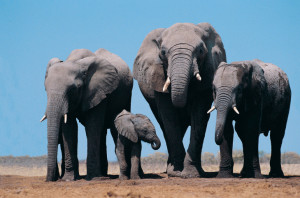 Elephants are some of the most majestic creatures known to man. They primarily live in the savannahs, forests, marshes and deserts of sub-Saharan Africa, South Asia and Southeast Asia. Elephants are important figures in religion and mythology. There were several million African elephants and approximately 100,000 Asian elephants living at the start of the 20th century. Today those numbers have shrunk to roughly 450,000-700,000 African elephants and 35,000-45,000 Asian elephants. The treatment of these animals in circuses and zoos has been criticized for years, and they have been hunted for their ivory for centuries.
Elephants are some of the most majestic creatures known to man. They primarily live in the savannahs, forests, marshes and deserts of sub-Saharan Africa, South Asia and Southeast Asia. Elephants are important figures in religion and mythology. There were several million African elephants and approximately 100,000 Asian elephants living at the start of the 20th century. Today those numbers have shrunk to roughly 450,000-700,000 African elephants and 35,000-45,000 Asian elephants. The treatment of these animals in circuses and zoos has been criticized for years, and they have been hunted for their ivory for centuries.
Religious and Mythological Significance
Elephants are religious symbols in many Asian cultures and represent intelligence, strength, dignity, peace and longevity.
- Hinduism
Lord Ganesha, the elephant god, is the most universally worshiped Hindu deity. He is exalted by devotees and believed to represent “perfect wisdom” and be the “remover of obstacles.” His image graces the entryways of temples and is also found at workplaces. Followers pray to Ganesha before they begin a new venture because they believe he will remove any obstacles to success.
- Buddhism
To Buddhists, the elephant represents mental strength. Dharma (the teachings of Buddha) and mediation are important aspects of this religion. The gray elephant symbolizes someone first learning Buddhism whose mind can run wild and wreak havoc at any time. The white elephant signifies a mind under control, which is extremely powerful and can be used to destroy any obstacle.
- Indian Mythology
Flying elephants are often depicted in Indian mythology, and the white elephant Airavata is the most highly regarded. He has four tusks and seven trunks and is seen carrying the Hindu god Indra on his back. Airavata is also believed to have the power to produce rain. Indian kings owned elephants and used them in wars.
Treatment in Zoos and Circuses
For most people, the only way to see a live elephant is to visit a zoo or circus. Animal rights groups have vehemently criticized both institutions for years over their treatment of these animals. Some of the primary complaints are inadequate room to roam, reckless breeding and exposure to cold climates. Zoos often rely on claims of species conservation as a justification for keeping elephants in captivity. In 2013, the international animal protection organization In Defense of Animals (IDA) named the following zoos as the three worst for elephants:
- San Antonio Zoo, San Antonio, Texas
- Edmonton Valley Zoo, Edmonton, Canada
- Little Rock Zoo, Little Rock, Arkansas
Elephants have been used as one of the headline acts in circuses for over a century. PETA (People for the Ethical Treatment of Animals) and a number of other organizations have fought for many years to stop elephant acts in circuses citing inhumane treatment. They have staged protests outside of performances and advocated for legislation prohibiting the use of elephants in circuses in certain parts of the country. Other efforts include pushing for a ban on the devices used by animal trainers to corral groups of elephants. In early March, bowing to intense pressure and changing sentiments about the use of animals in the circus, Ringling Bros and Barnum and Bailey Circus announced they would stop featuring elephants by 2018.
Ivory
The ivory from elephant tusks has been highly prized for a millennium. In order to extract its ivory, an elephant must first be killed. According to Time Magazine, 30,000 elephants are slaughtered each year for their tusks. Ivory is used for piano keys, furniture inlays, elaborate seals, jewelry and in many other ways. Ironically, it is also used for the faces and hands of Catholic icons and rosary beads.
Fewer and fewer elephants roam the earth. Protecting and treating them with kindness is the best way to ensure the longevity of this noble species.

